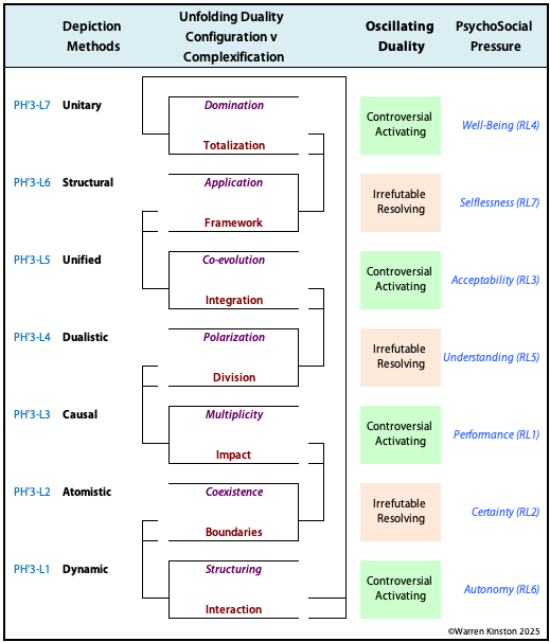Configuration versus Complexification
The Unfolding Duality
Reminder: Unfolding dualities appear to be characteristic of Principal Typologies and Structural Hierarchies, although their function, other than integrating adjacent Levels/Types, is as yet unknown.
Unfolding dualities appear to be characteristic of Principal Typologies and Structural Hierarchies, although their function, other than integrating adjacent Levels/Types, is as yet unknown.
Each Type in a Principal Typology can be characterized by a thesis and an antithesis, which are brought together in a synthesis, which is the thesis of the next higher Type. Previous work has suggested that the intrinsic tension in the duality is in general terms between:
- a ground state: a thesis that is the basic and unavoidable core of the Type
&
- a growth force: its antithesis and the potential for development of the Type.
Cf: stabilization methods (PH'4), ethical choice methods (PH'6)
use of language methods (PH'5), primal quests (RH').
For the depiction paradigms, the proposed generalized form of this duality is:
Configuration — the ground state or core of any depiction paradigm
&
Complexification — its development potential or growth force.
The Seven Dualities
L'1: Dynamic
Interaction v Structuring
 Detail
Detail
The core of the dynamic paradigm-L'1 is the presence of interacting elements capable of providing each other with feedback to enable a directed evolution of the situation. The basic configuration is therefore interaction.
However, simple interaction has its limits as a model because it becomes too fluid and confusing once the number of elements increases and makes the system more complex. The solution is for those elements to be structured into a stable and more sophisticated pattern.
Synthesis: Structured interaction naturally gives rise to boundaries between components.
L'2: Atomistic
Boundaries v Coexistence
 Detail
Detail
The core of the atomistic paradigm-L'2 is the presence of boundaries that are respected and generate discrete components of the situation expected to function independently and self-sufficiently.
However, complexity in the situation results as the number of individuals (components) increases and this is only manageable if there is an acceptance and willing coexistence.
Synthesis: The coexistence of numerous bounded entities naturally gives rise to impacts between at least some of them.
L'3: Causal
Impact v Multiplicity
 Detail
Detail
The core of the causal paradigm-L'3 is the requirement that some bounded entities in the situation impact on each other with predictable effects. This is viewed as causation.
Causal models become more complex and sophisticated if a component has multiple influences and if the number of components having or potentially having an influence on others multiplies.
Synthesis: Perception of a multiplicity of impacts in a situation creates overwhelming confusion that calls for simplification via a binary division.
L'4: Dualistic
Division v Polarization
 Detail
Detail
The core of the dualistic paradigm-L'4 is the presence of a division that represents a dichotomy and generates opposition between two sides.
Complexification results from that opposition becomes increasingly polarized. Polarization amplifies, sharpens and systematizes the differences between the two sides. As the degree of conflict escalates, the situation becomes more and more structured around the division.
Synthesis: The polarization that emerges from division must be resolved to avert a breakdown of the situation, and this is possible by integration of the opposing positions within a whole.
L'5: Unified
Integration v Co-evolution
 Detail
Detail
The core of the unified paradigm-L'5 is depicting in a way that fully integrates components with all their inner complexity, differences and divisions, and also includes interactions with the environment.
Depiction becomes more complex with time as co-evolution occurs and requires dynamic adjustment of all parts.
Synthesis: Integration of co-evolving components generates a stable framework which provides clarity about the component functions, roles and connections.
L'6: Structural
Framework v Application
 Detail
Detail
The core of the structural paradigm-L'6 is the presence of an ordered usable framework defining components, their functions and how they interact via roles and rules.
This schema can act as a template and be repeatedly applied. However, that develops complexity because every application will necessarily be slightly different and potentially require tweaks or extensions or sub-frameworks that need to be incorporated.
Synthesis: A powerful framework that gets repeatedly and effectively applied results in a total grasp of those situations.
L'7: Unitary
Totalization v Domination
 Detail
Detail
The core of the unitary paradigm-L'7 is representation as an undifferentiated single whole: a totality, that simply stays, or may expand or contract—but without concern for internal contents (individuals) or for the environment.
The totalization may be progressively extended and elaborated by the need to suppress alternatives, enforce conformity and extend uniformity through unequivocal spreading domination of all entities (e.g. institutions in a society).
Synthesis: Totalization and domination generate a rigidity and homogeneity that provides stability at the price of freezing all independent functioning. But total suppression of component function creates countervailing forces...
...leading to emergence of interaction the thesis of dynamic depiction L'1.
Summary of Dualities
See diagram below, which also includes the oscillating duality and the psychosocial pressures at play in the paradigms.

Originally posted: 20-Apr-2025
![]() Detail
Detail![]() Detail
Detail![]() Detail
Detail![]() Detail
Detail![]() Detail
Detail![]() Detail
Detail![]() Detail
Detail